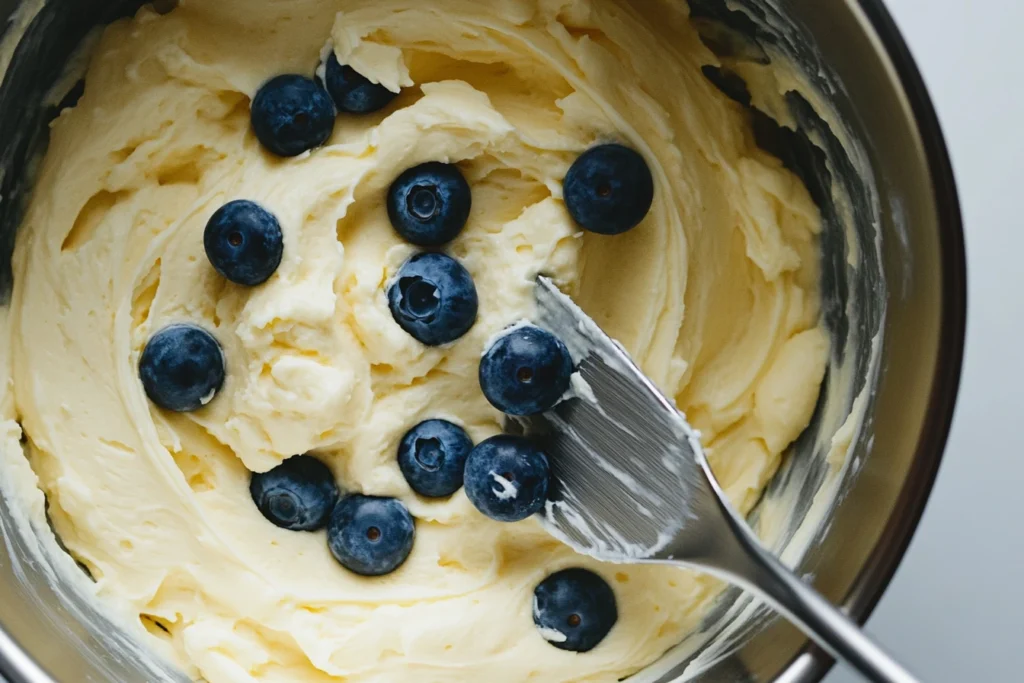Introduction
There’s something irresistibly charming about a homemade lemon blueberry pound cake. The combination of tangy lemon zest and juicy, sweet blueberries baked into a moist, buttery pound cake creates a dessert that’s hard to beat. Whether you’re looking for a refreshing treat for summer picnics or a cozy winter indulgence, this versatile cake delivers a perfect balance of flavors.
Lemon Blueberry Pound Cake – A Perfect Fusion of Zesty Lemon and Sweet Blueberries
Lemon blueberry pound cake isn’t just a dessert; it’s an experience. This classic cake gets its name from the traditional method of using equal parts of flour, butter, sugar, and eggs—creating a dense yet tender crumb that’s utterly satisfying. Adding lemon and blueberries elevates the flavor, creating a cake that’s rich, vibrant, and packed with summery goodness.
This pound cake is ideal for all kinds of occasions. From brunches to birthday parties or even as an afternoon tea companion, its versatility makes it a favorite among baking enthusiasts and dessert lovers alike.
The Origins of Pound Cake
Pound cake dates back to the early 18th century when it was made using a pound of each main ingredient: flour, sugar, butter, and eggs. This straightforward formula produced a hefty cake with a dense texture, ideal for feeding large families or gatherings. Over the years, the recipe evolved, incorporating flavorings like vanilla, spices, or citrus.
Adding ingredients like lemon zest and blueberries creates a delightful twist on this classic dessert. The lemon’s zesty aroma pairs beautifully with the sweet-tart burst of blueberries, offering a bright and fresh take on the traditional pound cake.
Why Lemon Blueberry Pound Cake Stands Out
What sets lemon blueberry pound cake apart is its balance of flavors and textures. The tanginess of fresh lemon juice and zest cuts through the richness of the butter, while the blueberries provide bursts of natural sweetness. The moist, tender crumb ensures each bite melts in your mouth, leaving you craving more.
If you’ve ever wondered why certain pound cakes taste dense or dry, the secret lies in using the right ingredients and mixing techniques. Don’t worry—we’ll cover all the tips and tricks you need to achieve a cake that’s as moist as it is delicious.
What Is Lemon Blueberry Pound Cake?
What Makes a Pound Cake Special?
Pound cakes are famous for their rich, buttery texture and simplicity. The original recipe, as its name suggests, used a pound each of butter, sugar, eggs, and flour. This no-frills approach resulted in a dense cake that was satisfying, filling, and ideal for large families or special occasions.
What makes this type of cake unique is its texture. Unlike lighter sponge cakes or airy chiffons, pound cakes are heavier but still tender, making them perfect for enjoying plain, with a glaze, or alongside fresh fruits. With just the right balance of sweetness and moisture, it’s a dessert that can easily stand alone or shine as part of a more elaborate spread.
Lemon Blueberry Pound Cake – A Delicious Variation
Adding lemon and blueberries to the classic pound cake transforms it into something truly extraordinary. The lemon zest and juice bring a tangy brightness that cuts through the richness, while the blueberries add pockets of sweetness and color. These elements not only elevate the taste but also create a dessert that feels lighter and more refreshing.
But that’s not all. The blueberries, whether fresh or frozen, add a touch of natural juiciness to the cake. Paired with the citrusy aroma of lemons, it’s a dessert that tastes like summer in every bite. Even on a cold day, this cake can transport you to sunnier moments.
The Magic of Combining Lemon and Blueberries
Why do lemon and blueberries work so well together? It’s all about contrast. The tang of the lemon enhances the natural sweetness of the blueberries, creating a flavor profile that’s balanced yet bold. It’s like a duet where each ingredient brings out the best in the other.
For example, the zest from the lemon peel adds aromatic oils that permeate the batter, ensuring every slice is packed with citrusy goodness. Meanwhile, the blueberries bake into juicy, jam-like pockets that burst with sweetness. This pairing ensures that each bite is an exciting mix of flavors and textures.

Ingredients for Lemon Blueberry Pound Cake
Key Ingredients for the Perfect Cake
Creating the ideal lemon blueberry pound cake requires the perfect combination of ingredients. Each one plays a crucial role in balancing flavors, creating structure, and delivering that tender crumb. Let’s take a closer look at the key components of this recipe.
Essential Cake Ingredients
- All-Purpose Flour: This forms the structure of the cake. Sifting the flour ensures a lighter texture and prevents lumps in the batter.
- Baking Powder: A leavening agent that helps the cake rise to the perfect height without being too dense.
- Salt: Just a pinch enhances all the flavors, making the lemon zest and blueberries shine.
Flavor Enhancers
- Lemon Zest and Juice: These are the stars of the show! The zest delivers a burst of aromatic oils, while the juice provides the tangy flavor that makes this cake so refreshing.
- Blueberries: Whether you use fresh or frozen blueberries, they’re the sweet counterpoint to the lemon’s tartness. Tossing them in a little flour before adding them to the batter ensures they don’t sink to the bottom.
Moisture and Texture Agents
- Unsalted Butter: Butter is key to the cake’s rich, tender crumb. Make sure it’s softened to room temperature for easy creaming with sugar.
- Granulated Sugar: Sugar sweetens the batter and helps create a golden crust during baking.
- Eggs: Eggs bind the ingredients together and add richness. Use them at room temperature for better incorporation into the batter.
- Milk or Buttermilk: These liquids add moisture to the batter, ensuring your cake isn’t dry. Buttermilk, in particular, brings a slight tang that complements the lemon beautifully.
Importance of Using Fresh and Quality Ingredients
High-quality, fresh ingredients make all the difference in baking, especially for a recipe as simple as pound cake.
- Lemons: Choose bright yellow lemons with smooth skin. They should feel heavy for their size, indicating they’re juicy. Organic lemons are preferable if you’re using the zest since they’re free from wax and pesticides.
- Blueberries: Look for firm, plump berries. If using frozen, don’t thaw them before mixing, as that can cause the berries to bleed into the batter.
- Butter and Eggs: These should be fresh and at room temperature for smooth mixing. Room-temperature ingredients help the batter emulsify, which is essential for a tender cake.
Ingredient Substitutions and Tips
If you’re missing certain ingredients, don’t worry! This recipe is flexible:
- Greek Yogurt or Sour Cream: These can replace buttermilk and add even more tang and moisture.
- Frozen Blueberries: If fresh ones aren’t available, frozen berries work just as well—just toss them in flour before adding them to the batter.
- Vanilla Extract: While optional, a splash of vanilla enhances the overall flavor, adding warmth to the lemony tang.

Step-by-Step Recipe for Lemon Blueberry Pound Cake
How to Make Lemon Blueberry Pound Cake – A Step-by-Step Guide
Now that you’ve gathered your high-quality ingredients, it’s time to put them to work. This step-by-step guide will walk you through the process of making a lemon blueberry pound cake that’s moist, flavorful, and picture-perfect.
Preparation
Before diving into the mixing process, a little prep work ensures everything runs smoothly:
- Preheat the Oven: Set your oven to 350°F (175°C) and position the rack in the center. A consistent baking temperature is key to an evenly baked cake.
- Grease and Prepare the Pan: Grease your loaf or bundt pan with butter or non-stick spray, and lightly dust it with flour. This prevents sticking and makes unmolding easier.
- Measure Ingredients Accurately: Baking is a science, so use a kitchen scale or measuring cups for precision. Sift the dry ingredients to avoid lumps.
- Toss Blueberries in Flour: Lightly coating the blueberries in flour keeps them from sinking to the bottom of the batter.
Mixing the Batter
- Cream the Butter and Sugar: In a large mixing bowl, beat the softened butter and granulated sugar until the mixture is pale and fluffy. This step aerates the batter, ensuring a tender crumb.
- Add the Eggs: Crack in the eggs one at a time, beating well after each addition. This helps to fully incorporate the eggs and maintain the batter’s emulsion.
- Incorporate Lemon Flavor: Mix in the lemon zest, lemon juice, and a splash of vanilla extract if using. The citrus aroma will begin to fill the kitchen!
- Combine the Dry and Wet Ingredients: Gradually add the sifted dry ingredients (flour, baking powder, and salt) in batches, alternating with the milk or buttermilk. Start and end with the dry ingredients for the smoothest batter.
- Fold in the Blueberries: Gently fold in the floured blueberries using a spatula. Be careful not to overmix, as this can make the cake dense and cause the berries to break.
Baking the Cake
- Pour the Batter into the Pan: Carefully transfer the batter into your prepared pan, smoothing the top with a spatula.
- Bake to Perfection: Place the pan in the oven and bake for 50–60 minutes for a loaf pan or 60–70 minutes for a bundt pan. Check for doneness by inserting a toothpick into the center; it should come out clean or with a few moist crumbs.
- Avoid Overbaking: Keep an eye on the cake during the final minutes. Overbaking can dry out the crumb, robbing the cake of its signature moist texture.
Cooling and Serving
- Cool in the Pan: Let the cake cool in the pan for 10–15 minutes before turning it out onto a wire rack. Cooling it slightly prevents it from breaking apart.
- Transfer and Finish Cooling: Once out of the pan, allow the cake to cool completely before slicing or glazing. A warm cake may crumble or cause the glaze to run.
Optional: Add a Lemon Glaze
For an extra burst of citrus flavor, drizzle a simple lemon glaze over the cooled cake:
- Ingredients: 1 cup powdered sugar, 2 tablespoons fresh lemon juice, and 1 teaspoon lemon zest.
- Directions: Whisk the ingredients together until smooth, then pour over the cake and let it set for a few minutes.
Tips and Tricks for the Best Lemon Blueberry Pound Cake
Common Mistakes to Avoid
While baking a lemon blueberry pound cake might seem straightforward, a few common pitfalls can derail your efforts. Avoiding these mistakes will ensure a moist, flavorful, and picture-perfect cake every time.
- Overmixing the Batter: It’s tempting to keep mixing until the batter looks silky smooth, but overmixing develops too much gluten, making the cake dense and chewy. Gently fold in the ingredients to keep the crumb tender.
- Blueberries Sinking to the Bottom: If you skip the step of tossing your blueberries in a bit of flour, they’ll likely sink to the bottom during baking. That simple flour coating creates just enough friction to suspend them evenly throughout the batter.
- Baking at the Wrong Temperature: Always preheat your oven and bake at the specified temperature. An oven that’s too hot or too cool can cause uneven baking, resulting in a burnt crust or an underbaked center.
Expert Tips for Success
If you want to take your lemon blueberry pound cake to the next level, these pro tips will help you perfect the recipe:
- Room-Temperature Ingredients: Ensure your butter, eggs, and milk or buttermilk are at room temperature. This allows them to blend more easily, creating a smoother batter that bakes evenly.
- Don’t Skip the Zest: Lemon zest is packed with aromatic oils that give the cake its signature citrusy flavor. Use a fine grater or microplane to zest only the yellow part of the lemon—avoiding the bitter white pith.
- Pan Preparation is Key: Even the most delicious batter won’t matter if the cake sticks to the pan. Grease the pan generously and dust it with flour for an easy release. For bundt pans with intricate designs, use a pastry brush to coat every nook and cranny.
- Test for Doneness Properly: Insert a toothpick or skewer into the thickest part of the cake. If it comes out clean or with just a few moist crumbs, the cake is done. Avoid opening the oven door too often during baking, as this can cause the cake to sink.
Adjusting Baking Time for Different Pans
One of the great things about this cake is its versatility—you can bake it in different pans for various occasions. However, each pan type requires slight adjustments:
- Loaf Pan: A single loaf pan will need about 50–60 minutes of baking time.
- Bundt Pan: The larger size of a bundt pan requires a longer bake time, typically 60–70 minutes.
- Mini Loaves or Muffins: If you’re making smaller portions, reduce the baking time to 20–30 minutes and keep an eye on them for doneness.
Add a Glaze for Extra Sweetness
While this cake is delicious on its own, a glaze can take it to the next level. Whether you go with a tangy lemon glaze or a simple vanilla drizzle, it adds both flavor and visual appeal.
- Pro Tip: For a thicker glaze, add more powdered sugar. For a thinner drizzle, use more lemon juice or milk. Either way, let it set before serving for a polished presentation.
Variations of Lemon Blueberry Pound Cake
Creative Twists on the Classic Recipe
The beauty of a lemon blueberry pound cake lies in its versatility. With just a few tweaks, you can transform this classic dessert into a unique creation that suits your taste or dietary needs. Here are some fun and creative variations to try.
Lemon Blueberry Bundt Cake
Swap out the loaf pan for a bundt pan, and you instantly elevate your cake’s presentation. The bundt shape not only looks elegant but also provides more surface area for a glaze or drizzle to cling to, creating a show-stopping dessert.
- Tip: Use a non-stick bundt pan and grease it meticulously to ensure the cake releases easily.
Lemon Blueberry Loaf Cake
If you’re aiming for a more casual, sliceable option, stick with the classic loaf pan. This version is perfect for serving with coffee or tea and is easier to transport to gatherings.
- Variation: Add a crunchy streusel topping made with brown sugar, flour, and butter for an added layer of texture.
Gluten-Free Lemon Blueberry Pound Cake
For those with dietary restrictions, creating a gluten-free version is simple. Substitute all-purpose flour with a 1:1 gluten-free baking flour blend.
- Tip: Add an extra egg to improve structure and prevent the cake from becoming too crumbly.
Vegan Lemon Blueberry Cake
Make it plant-based by replacing eggs with flaxseed meal or unsweetened applesauce and using plant-based butter and milk alternatives.
- Pro Tip: Coconut milk adds richness while almond or oat milk provides a lighter flavor.
Adding Extra Flavors
If you’re in the mood to experiment, here are some additional ingredients that can enhance the flavor of your lemon blueberry pound cake:
- White Chocolate Chips: Stir a handful of white chocolate chips into the batter for a sweet, creamy contrast to the lemony tang.
- Almond Extract: Swap out or combine vanilla extract with almond extract for a nutty undertone.
- Fresh Herbs: Add a hint of finely chopped basil or thyme for an unexpected herbal twist that pairs beautifully with lemon.
- Spices: Incorporate ground cinnamon or cardamom for warmth and complexity.
Seasonal Variations
Adapt your lemon blueberry pound cake to match the seasons:
- Spring and Summer: Stick with the classic lemon and blueberry combo for a bright, refreshing treat.
- Fall: Substitute blueberries with cranberries or blackberries and add a hint of orange zest for a seasonal flair.
- Winter: Use frozen blueberries and drizzle the cake with a rich cream cheese glaze for a cozy, indulgent dessert.
Why Experimenting Is Worth It
Whether you’re tweaking ingredients for dietary needs or adding flavors to suit the season, experimenting with this recipe is incredibly rewarding. You’ll find that each variation brings its own unique charm, but the cake’s moist, tender texture and balance of sweet and tangy flavors remain constant.
Storage, Freezing, and Reheating
How to Store Lemon Blueberry Pound Cake
Once you’ve baked your perfect lemon blueberry pound cake, storing it correctly is essential to maintain its flavor and texture. Improper storage can lead to dryness or a loss of that fresh, moist crumb everyone loves. Here’s how to keep your cake as good as the day you made it:
- Room Temperature Storage: If you plan to eat the cake within 2–3 days, storing it at room temperature works just fine. Wrap the cake tightly in plastic wrap or aluminum foil, or place it in an airtight container to prevent it from drying out. Keep it away from direct sunlight and heat.
- Refrigeration for Longer Freshness: For storage beyond three days, refrigerate the cake. Wrap it in plastic wrap and store it in an airtight container to lock in moisture. Refrigerated cake can last up to a week.
Can You Freeze Lemon Blueberry Pound Cake?
Yes, you absolutely can! Freezing is a fantastic way to extend the shelf life of your lemon blueberry pound cake while preserving its flavor and texture. Follow these steps for the best results:
- Cool the Cake Completely: Before freezing, let the cake cool entirely to room temperature. Freezing a warm cake can lead to excess condensation, which may cause sogginess.
- Wrap It Tightly: Wrap the cake in plastic wrap, ensuring no part is exposed to air. For added protection, wrap it again in aluminum foil or place it in a freezer-safe bag.
- Label and Freeze: Label the package with the date and store it in the freezer for up to three months.
- Pro Tip: If you’ve added a glaze, it’s best to freeze the cake without it and add the glaze after thawing for the freshest taste.
Reheating Tips to Retain Moisture
When you’re ready to enjoy your frozen pound cake, proper reheating ensures it tastes just as good as when it was freshly baked:
- Thawing: Remove the cake from the freezer and allow it to thaw in the refrigerator overnight. If you’re short on time, you can leave it at room temperature for a few hours.
- Warming It Up: For that just-baked feel, wrap the thawed cake in foil and warm it in a preheated oven at 325°F (160°C) for about 10–15 minutes. This refreshes the crumb and enhances the aroma.
- Microwave Option: For a quick slice, microwave individual portions for 10–15 seconds.
Best Practices for Glazed Cakes
If your cake is glazed, store and freeze it a bit differently:
- For short-term storage, cover the glaze lightly with wax paper before wrapping the cake to avoid sticking.
- For freezing, wrap the cake as you would a plain version, but consider freezing it unglazed to maintain the best texture.
Frequently Asked Questions
Do lemon and blueberry taste good together?
Absolutely! Lemon and blueberry are a match made in flavor heaven. The bright, tangy zing of lemon perfectly complements the natural sweetness of blueberries, creating a balance that’s both refreshing and satisfying. Lemon enhances the fruity notes of blueberries, while blueberries add bursts of juiciness to every bite. This pairing is ideal not just for pound cakes but also for muffins, tarts, and even pancakes. Together, they deliver a vibrant and summery taste that’s hard to resist.
How do you keep blueberries from sinking in a pound cake?
To keep blueberries from sinking to the bottom of your lemon blueberry pound cake, here are a few foolproof tricks:
- Toss the Blueberries in Flour: Coat the blueberries lightly in a tablespoon of flour before folding them into the batter. This helps them stay suspended rather than sinking during baking.
- Thick Batter is Key: A thicker cake batter provides more support for the blueberries, so they don’t drop to the bottom. Avoid adding too much liquid to the mix.
- Use Smaller Berries: Smaller blueberries are less likely to sink compared to larger ones, as they are lighter and distribute more evenly throughout the batter.
With these tips, your blueberries will be perfectly spread throughout your cake, adding bursts of flavor in every bite.
How much lemon juice can I add to a box cake mix?
When enhancing a box cake mix with lemon juice, moderation is key to achieving the right balance. You can add up to 2–3 tablespoons of fresh lemon juice without altering the texture of the cake too much.
- Pro Tip: Pair the lemon juice with 1 teaspoon of lemon zest for a more concentrated citrus flavor. If the batter feels too thin after adding the juice, reduce the amount of water or milk in the box mix slightly. This ensures the cake remains moist without becoming too dense.
Adding lemon juice and zest can transform a plain box cake mix into a vibrant, citrusy treat.
Why is my Lemon Pound Cake dry?
A dry lemon pound cake is often the result of a few common mistakes, but thankfully, they’re easy to fix:
- Overbaking: Baking the cake for too long or at too high a temperature can dry it out. Always check for doneness with a toothpick and remove the cake from the oven as soon as it comes out clean.
- Not Enough Moisture: If the recipe doesn’t include enough liquid ingredients (like milk, buttermilk, or sour cream), the cake may lack the moisture needed for that soft crumb.
- Overmixing the Batter: Mixing the batter too much can overdevelop the gluten in the flour, leading to a tougher, drier cake.
- Incorrect Measurements: Too much flour can cause dryness. Use a kitchen scale or the spoon-and-level method to measure accurately.
To prevent dryness, ensure your ingredients are fresh, measure precisely, and follow the recipe’s baking times carefully. For added moistness, you can brush the cooled cake with a simple syrup made of lemon juice and sugar.

Conclusion
A lemon blueberry pound cake isn’t just a dessert—it’s a celebration of flavors, textures, and the joy of baking. From its zesty lemon aroma to the sweet bursts of blueberries in every bite, this cake is a versatile treat that’s perfect for any occasion. Whether you’re serving it plain, glazed, or with a side of whipped cream, it’s a guaranteed crowd-pleaser.
By following the tips, tricks, and variations shared in this article, you can create a cake that’s moist, tender, and packed with vibrant flavor. Remember, the secret lies in using fresh, high-quality ingredients, taking your time with preparation, and embracing the fun of experimenting with flavors.

